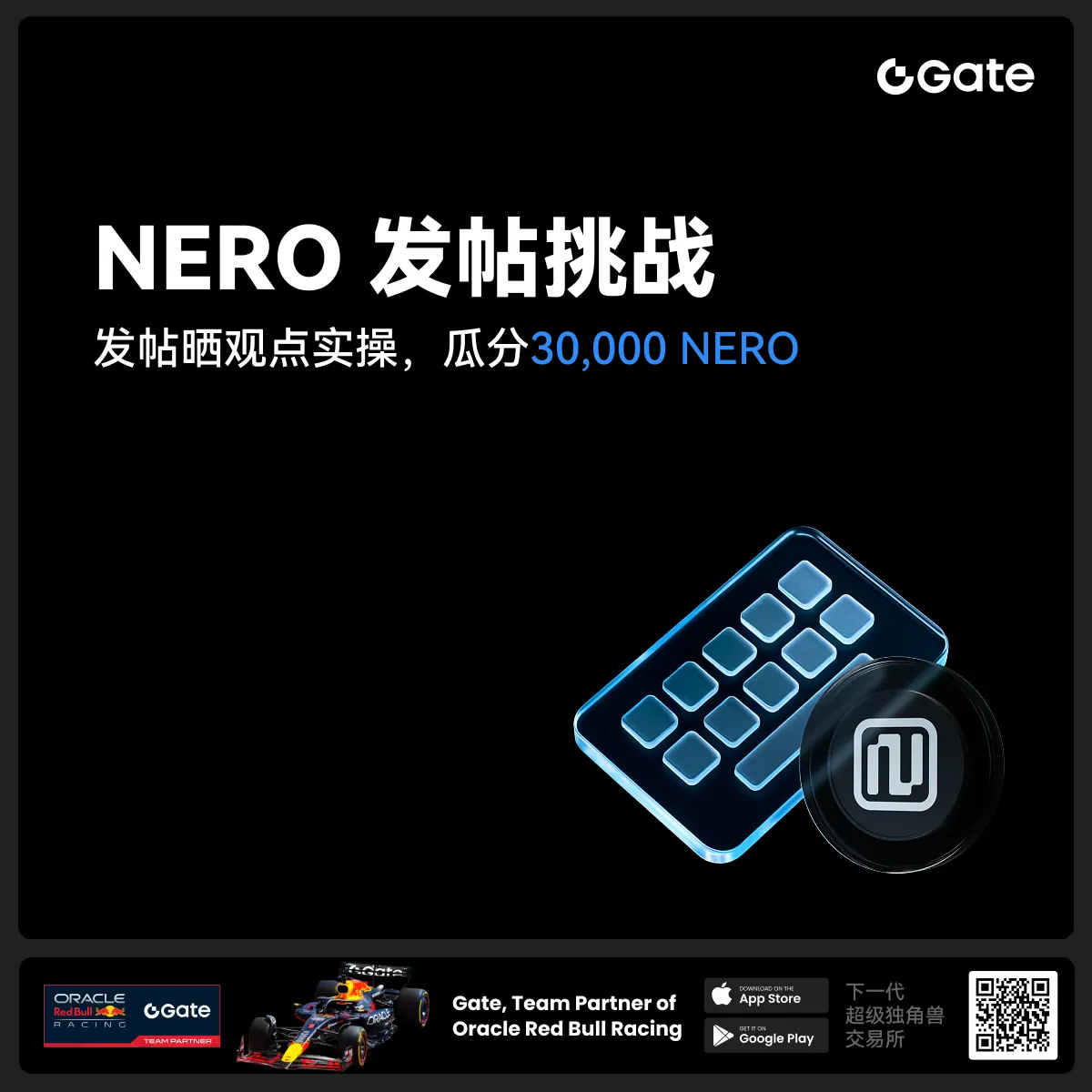- 话题1/3
27k 热度
18k 热度
36k 热度
8k 热度
20k 热度
- 置顶
- 🎉 #CandyDrop合约挑战# 正式开启!参与即可瓜分 6 BTC 豪华奖池!
📢 在 Gate 广场带话题发布你的合约体验
🎁 优质贴文用户瓜分$500 合约体验金券,20位名额等你上榜!
📅 活动时间:2025 年 8 月 1 日 15:00 - 8 月 15 日 19:00 (UTC+8)
👉 活动链接:https://www.gate.com/candy-drop/detail/BTC-98
敢合约,敢盈利
- 🎉 攒成长值,抽华为Mate三折叠!广场第 1️⃣ 2️⃣ 期夏季成长值抽奖大狂欢开启!
总奖池超 $10,000+,华为Mate三折叠手机、F1红牛赛车模型、Gate限量周边、热门代币等你来抽!
立即抽奖 👉 https://www.gate.com/activities/pointprize?now_period=12
如何快速赚成长值?
1️⃣ 进入【广场】,点击头像旁标识进入【社区中心】
2️⃣ 完成发帖、评论、点赞、发言等日常任务,成长值拿不停
100%有奖,抽到赚到,大奖等你抱走,赶紧试试手气!
截止于 8月9日 24:00 (UTC+8)
详情: https://www.gate.com/announcements/article/46384
#成长值抽奖12期开启#
- 📢 Gate广场 #NERO发帖挑战# 秀观点赢大奖活动火热开启!
Gate NERO生态周来袭!发帖秀出NERO项目洞察和活动实用攻略,瓜分30,000NERO!
💰️ 15位优质发帖用户 * 2,000枚NERO每人
如何参与:
1️⃣ 调研NERO项目
对NERO的基本面、社区治理、发展目标、代币经济模型等方面进行研究,分享你对项目的深度研究。
2️⃣ 参与并分享真实体验
参与NERO生态周相关活动,并晒出你的参与截图、收益图或实用教程。可以是收益展示、简明易懂的新手攻略、小窍门,也可以是行情点位分析,内容详实优先。
3️⃣ 鼓励带新互动
如果你的帖子吸引到他人参与活动,或者有好友评论“已参与/已交易”,将大幅提升你的获奖概率!
NERO热门活动(帖文需附以下活动链接):
NERO Chain (NERO) 生态周:Gate 已上线 NERO 现货交易,为回馈平台用户,HODLer Airdrop、Launchpool、CandyDrop、余币宝已上线 NERO,邀您体验。参与攻略见公告:https://www.gate.com/announcements/article/46284
高质量帖子Tips:
教程越详细、图片越直观、互动量越高,获奖几率越大!
市场见解独到、真实参与经历、有带新互动者,评选将优先考虑。
帖子需原创,字数不少于250字,且需获得至少3条有效互动
- 🎉 亲爱的广场小伙伴们,福利不停,精彩不断!目前广场上这些热门发帖赢奖活动火热进行中,发帖越多,奖励越多,快来GET你的专属好礼吧!🚀
1️⃣ #GateLaunchpad上线IKA# |IKA认购体验
在Gate广场带话题晒出你的IKA Launchpad认购体验,4位幸运分享者讲瓜分$200分享奖池!
详情 👉️ https://www.gate.com/post/status/12566958
2️⃣ #ETH冲击4800# |行情分析预测
大胆发帖预测ETH走势,展示你的市场洞察力!10位幸运用户将平分0.1 ETH 奖励!
详情 👉️ https://www.gate.com/post/status/12322403
3️⃣ #创作者活动第二期# |ZKWASM话题
在广场或推特发布与 ZKWASM 或其交易活动相关的原创内容,瓜分4,000枚ZKWASM!
详情 👉️ https://www.gate.com/post/status/12525794
4️⃣ #Gate广场征文活动第二期# |ERA话题
谈谈你对ERA的观点/体验,参与并推广活动,700 ERA大奖等你赢!
详情 👉️ https://www.gate.com/post/status/12361653
5️⃣ #MBG任务挑战# |MBG话题
分享你对MBG的洞察,积极参与和推广MBG活动,20位小 - 🎉Gate 2025 上半年社区盛典:内容达人评选投票火热进行中 🎉
🏆 谁将成为前十位 #Gate广场# 内容达人?
投票现已开启,选出你的心头好
🎁赢取 iPhone 16 Pro Max、限量周边等好礼!
📅投票截止:8 月 15 日 10:00(UTC+8)
立即投票: https://www.gate.com/activities/community-vote
活动详情: https://www.gate.com/announcements/article/45974
Fix AI’s data theft problem with onchain attribution
Opinion by: Ram Kumar, core contributor at OpenLedger
The public has knowingly contributed to the rise of artificial intelligence, often without realizing it. As AI models are projected to generate trillions of dollars in value, it’s time to start treating data like labor and building onchain attribution systems to pay the ones making it possible
X posts by users helped train ChatGPT, and their blog posts and forum replies shaped models that are now monetized by some of the most powerful companies in the world.
While those companies are reaping billions, the end-users get nothing. Not a check, a credit or even a thank you.
Data is work that deserves pay
This is what invisible labor looks like in the 21st century. Billions of people have become the unpaid workforce behind the AI revolution. The data they generate, from words, code, faces and movement, is scraped, cleaned and used to teach machines how to sound more human, sell more ads and close more trades.
And yet, in the economic loop that powers AI, the humans who make it all possible have been cut out entirely.
This story is not new. The same model built empires on the backs of uncredited creative labor. Only now, the scale is planetary. This isn’t just about fairness but about power and whether we want a future where intelligence is owned by three corporations or shared by all of us.
The only way to redefine the economics of intelligence is through Payable AI.
A new economic model for intelligence
Instead of black-box models trained in secret, Payable AI proposes a future where AI is built openly, with every contributor traceable and every use compensated. Every post, video or image used to train a model should carry a tag or a digital receipt. Every time that model is used, a small payment should be sent to the data’s original creator. That’s attribution, baked into the system.
This has precedent. Musicians now earn royalties when their tracks stream, and developers get credited when their open-source code is reused. AI should follow the same rules. Just because training data is digital doesn’t mean it’s free. If anything, it’s the most valuable commodity we have left.
The problem is that we’ve been treating AI like traditional software — something you build once and sell a million times. That metaphor, however, falls apart fast.
AI isn’t static. It learns, decays and improves with every interaction, weakening when data dries up. In this way, AI is more like a living ecosystem feeding on a continuous supply of human input, from language and behavior to creativity. Yet there’s no system to account for that supply chain and no mechanism to reward those who nourish it.
Related: AI race between US and China resembles Cold War — Marc Andreessen
Payable AI creates a circular economy of knowledge — an economic structure where participation equals ownership and where every interaction has traceable value.
Autonomous AI agents will be everywhere: booking services, negotiating contracts and running businesses in a few years from now. These agents will be transacting, and they’ll need wallets. They will also need access to fine-tuned models and must pay for data sets, APIs and human guidance.
We are headed toward machine-to-machine commerce, and the infrastructure isn’t ready.
The world needs a system to track what an agent used, where that intelligence came from, and who deserves to be paid. Without it, the entire AI ecosystem becomes a black market of stolen insights and untraceable decisions.
Who controls AI today?
Today’s complicated problems with AI pale compared to autonomous agents acting on people’s behalf, with no way to audit where their “intelligence” came from.
The deeper issue, though, is control.
Companies like OpenAI, Meta and Google are building models that will power everything from education to defense to economic forecasting. Increasingly, they own the terrain. And governments — whether in Washington, Brussels or Beijing — are rushing to catch up. XAI is being integrated into Telegram, and messaging, identity and crypto are increasingly merging
We have a choice. We can continue down this consolidation path, where intelligence is shaped and governed by a handful of platforms. Or we can build something more equitable: an open system where models are transparent, attribution is automatic and value flows back to the people who made it possible.
Laying the foundation for ethical AI
That will require more than new terms of service. It will demand new rights, like the right to attribution, the right to compensation and the right to audit the systems built on our data. It will require new infrastructure — wallets, identity layers and permission systems — that treat data not as exhaust but as labor.
It will also demand a legal framework that recognizes what’s happening: People are building value, which deserves recognition.
Right now, the world is working for free. But not for long. Because once people understand what they’ve given, they’ll ask what they’re owed.
The question is: Will we have a system ready to pay them?
We’re risking a future where the most powerful force on Earth — intelligence itself — is privatized, unaccountable and entirely beyond our reach.
We can build something better. First, we have to admit the current system is broken.
Opinion by: Ram Kumar, core contributor at OpenLedger.
This article is for general information purposes and is not intended to be and should not be taken as legal or investment advice. The views, thoughts, and opinions expressed here are the author’s alone and do not necessarily reflect or represent the views and opinions of Cointelegraph.